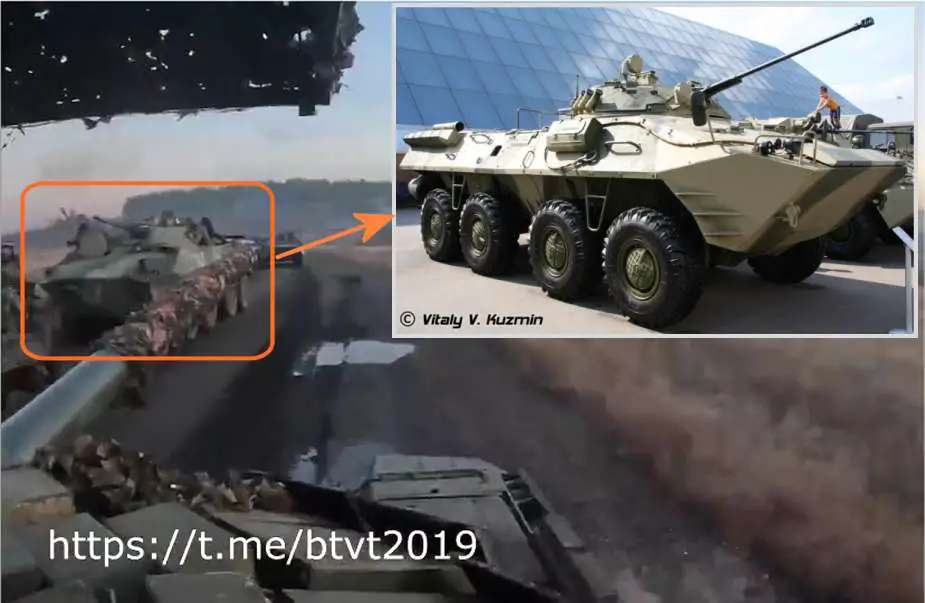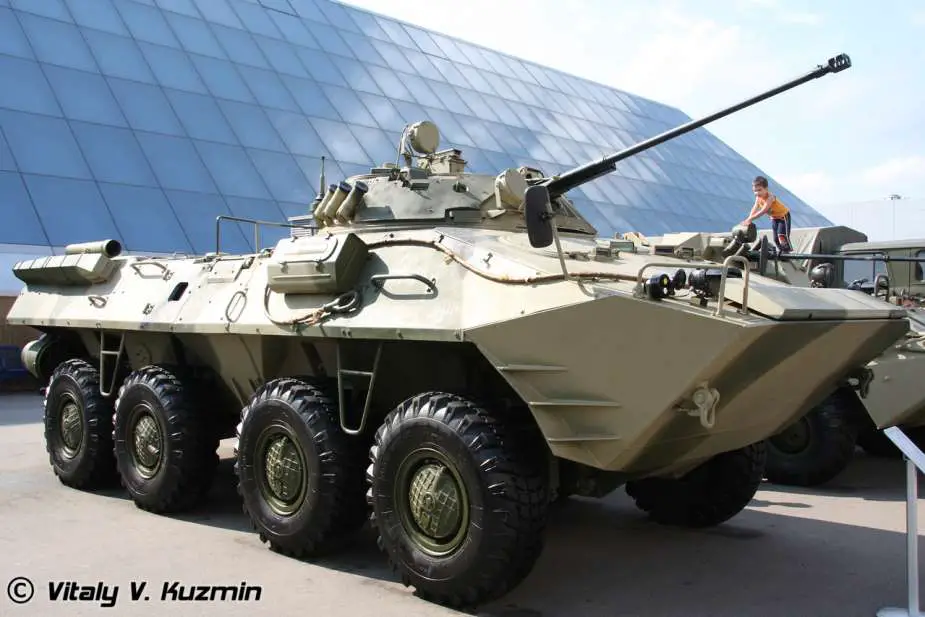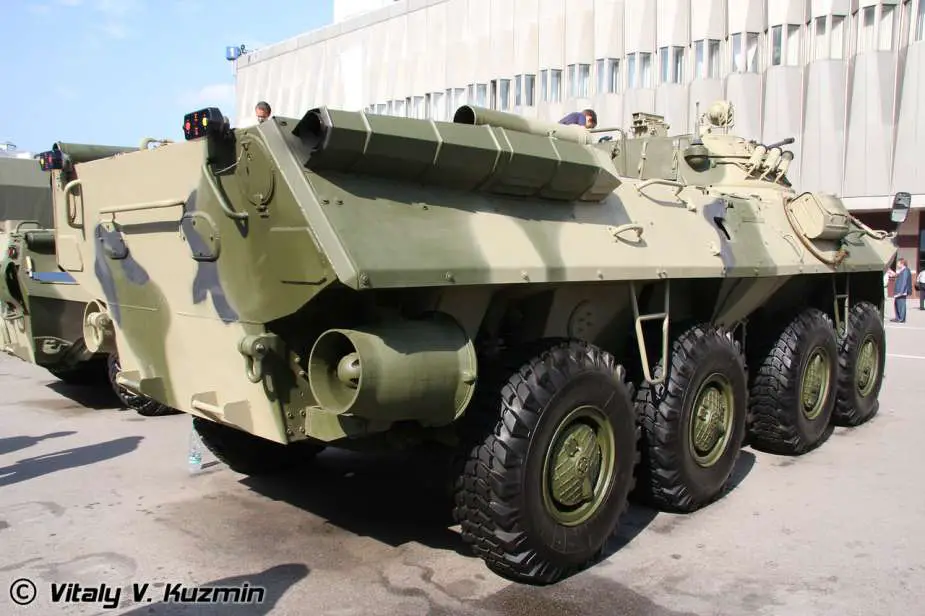According to Andrei_bt on October 13, 2023, in a surprising turn of events, a rare Russian military vehicle, the BTR-90 'Rostok' infantry fighting vehicle (IFV), was spotted in Ukraine, near the city of Avdiivka, located in the Donbas region. In total, only 12 BTR-90 armored personnel carriers (APCs) were ever built, including all variants. The BTR-90, officially adopted by the Russian Armed Forces through Order No. 324 on June 9, 2008, was never mass-produced.
Follow Army Recognition on Google News at this link

A BTR-90 APC, in a 'Rostok' IFV variant with the serial number 2B12LT1932, was spotted in Ukraine (Picture source: Twitter and Vitaly Kuzmin)
Each of the BTR-90 units produced encountered various fates. A few were repurposed with Bakhcha or Berezhok turrets, while others were destroyed during ballistic tests. Two of them are displayed in museums, with one at the Kubinka museum equipped with a 675-sb120-01 turret, and the other at Moscow's Patriot Park. Another of the 12 BTR-90s was converted into a hybrid drivetrain testbed. Finally, the one spotted in Ukraine is the No. 2B12LT1932, a 'Rostok' variant outfitted with the BMP-2 turret, which was displayed at the IDELF-2008 exhibition in Moscow.
However, the presence of this rare Russian BTR-90 in Ukraine raises numerous questions about its combat role and origin. According to military analyst Andriy Tarasenko, who has deep knowledge of armored vehicles from both the USSR and modern Russia, this specific vehicle was pulled from storage at the 38th Research Institute in Kubinka, Russia.
A few examples of the BTR-90 are currently in service with Russia's National Guard, so it is possible that the BTR-90 spotted near Avdiivka belongs to an NG unit. It's worth noting that, in the original video, the BMP-1 in front of the BTR-90 is marked as belonging to Russia's 114th Separate Guards Motorised Rifle Brigade (formerly the DNR 11th Motorised Rifle Regiment).
The BTR-90 was officially adopted by the Russian Armed Forces through Order No. 324 on June 9, 2008, but it was never mass-produced. Its appearance in Ukraine as part of a larger Russian combat vehicle column, including tanks, highlights a concerning trend, implying that Russian military stocks are being depleted to such an extent that even museum-worthy vehicles are being deployed to bolster their forces.
The BTR-90, or GAZ-5923, is a Russian 8x8 amphibious armored personnel carrier developed in the early 1990s by the Arzamas Machine-Building Plant in Russia as a potential addition to the Russian ground forces. It was officially adopted by the Russian Armed Forces in 2008. However, in 2011, the Russian Ministry of Defense chose to discontinue its procurement due to a reassessment of the Russian Ground Forces' armament concept. This decision was influenced by cost considerations, ultimately leading to the development of the BTR-82A and the unveiling of the K-17 Bumerang in 2015.
The BTR-90 has a combat weight between 20.5 and 22 tons, depending on the source, with a capacity for a crew of three (driver, vehicle commander, and gunner) and up to seven infantrymen. The vehicle measures 8.2 m in length, 3.1 m in width, and stands 3 m tall with a ground clearance of 510 mm. It is powered by a multi-fuel liquid-cooled, turbocharged, YaMZ 2V-06-2S 6-cylinder diesel engine delivering 510 horsepower, allowing a top speed of over 100 km/h on the highway and can maintain a speed of 12 km/h when afloat using two hydrojets. Its operational range, without refueling, varies from 600 to 800 km, depending on terrain conditions.

The same vehicle spotted in Ukraine was displayed at the IDELF-2008 exhibition in Moscow (Picture source: Vitaly Kuzmin)
The BTR-90, in its 'Rostok' Infantry Fighting Vehicle (IFV) variant, is armed with a variety of weaponry. As a main weapon, the APC shares the same gun as the BMP-2, a 30mm 2A42 automatic cannon with a capacity for 500 rounds, along with a coaxial 7.62mm PKTM machine gun with a capacity for 2,000 rounds. An AGS-17 automatic grenade launcher is mounted in the rear left part of the turret, capable of engaging targets at ranges of up to 1,700 m. The BTR-90 carries four 9K111-1M Konkurs-M anti-tank guided missiles (ATGM) and has provisions for two Igla Man-Portable Air-Defense Systems (MANPADS), along with one RPG-7 equipped with five rounds.
The vehicle can navigate slopes with angles of up to 30%, side slopes up to 25%, and vertical obstacles up to 0.6 m. It can cross natural or engineered trenches with a maximum depth of 2 m. Equipped with an automatic hydromechanical reversible gearbox, it allows for a "tank" turn by turning the four front wheels and the ability to move forward and backward at the same speed, effectively reducing its turning radius compared to previous Russian 8x8 APCs. The BTR-90 can also remain operational even if four of its eight wheels are damaged.
Independent torsion bar suspension of all wheels on wishbones, energy-intensive telescopic hydraulic shock absorbers, and wide-profile bullet-resistant tires with a centralized pressure control system ensure the ability to drive over rough terrain at speeds of more than 50 km/h.
The BTR-90 is the first domestic armored personnel carrier equipped with a BIUS onboard information and control system, providing automated control of the engine and transmission, as well as monitoring and diagnostics of the vehicle's main systems. The APC includes nuclear, biological, and chemical (NBC) protection, and the presence of air conditioning allows the vehicle to operate in hot climates.
The gunner-operator is equipped with a combined (day and night) sight BPK-Z-42, and the commander has a 1P-13 daytime observation device. There is a special 1P3-3 sight designed for anti-aircraft fire and an R-163-50U radio station for effective communication. The vehicle features an IR spotlight with a heat-protective casing. The BTR-90 is also equipped with additional features, such as a 2-belt powered loading mechanism and a 2E36-2 weapon stabilizer.
The BTR-90 boasts strengthened armor compared to its predecessor, the BTR-80, providing reliable protection against large-caliber bullets and artillery shell fragments. Its mine protection has been significantly enhanced with a V-shaped bottom, making it more resistant to shock waves compared to traditional flat bottoms.

The BTR-90 can maintain a speed of 12 km/h when afloat using two hydrojets (Picture source: Vitaly Kuzmin)















